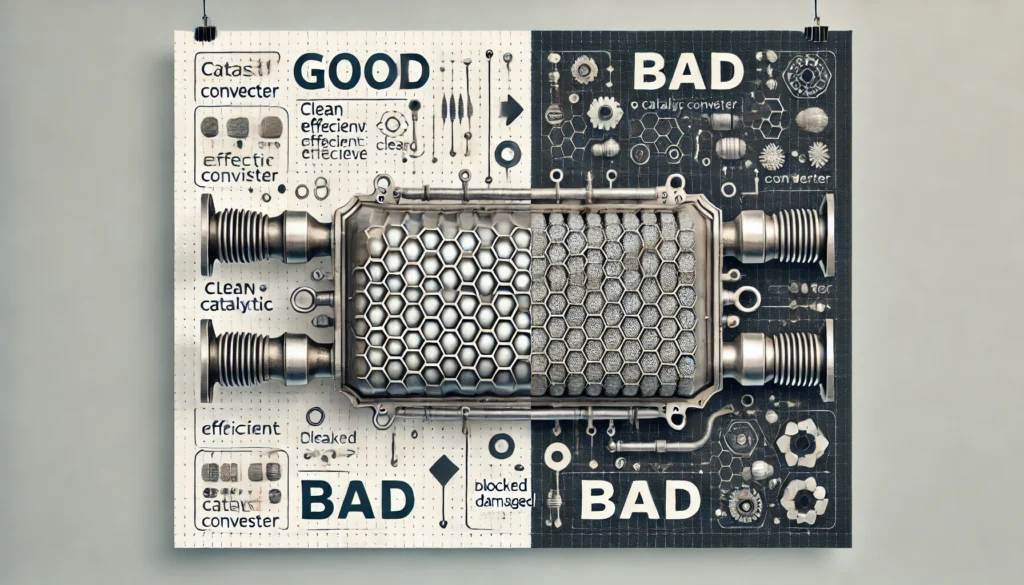When it comes to maintaining your vehicle, understanding the condition of your catalytic converter is crucial. A good catalytic converter is essential for reducing harmful emissions and ensuring your vehicle runs efficiently. On the other hand, a bad catalytic converter can lead to performance issues, increased pollution, and costly repairs. In this blog post, we’ll explore the key differences between a good and bad catalytic converter, how to spot the signs of a failing converter, and what actions you can take to keep your vehicle in top shape.

What Does a Catalytic Converter Do?
The catalytic converter is an integral part of your car’s exhaust system. Its primary function is to convert harmful pollutants from the engine’s exhaust into less harmful emissions before they exit the vehicle’s tailpipe. This process helps reduce the environmental impact of your vehicle and ensures compliance with emissions regulations.
Signs of a Good Catalytic Converter
A good catalytic converter will typically exhibit the following characteristics:
- Efficient Emissions Reduction
- A good catalytic converter effectively reduces harmful emissions, such as carbon monoxide, hydrocarbons, and nitrogen oxides. Your vehicle should pass emissions tests without any issues, and you won’t notice any unusual smells or smoke from the exhaust.
- Optimal Engine Performance
- When your catalytic converter is functioning correctly, your engine should run smoothly. You’ll experience responsive acceleration, good fuel efficiency, and consistent power output.
- No Unusual Noises
- A good catalytic converter will not produce any rattling, hissing, or other unusual noises. The internal components are intact, ensuring a quiet and efficient exhaust system.
- Clean Exhaust Flow
- A good catalytic converter allows for the smooth flow of exhaust gases, preventing any backpressure that could affect engine performance. The exhaust pipe should emit clear, odorless gases without any visible smoke.
Signs of a Bad Catalytic Converter
In contrast, a bad catalytic converter can cause several problems, including:
- Poor Engine Performance
- A failing catalytic converter can restrict the flow of exhaust gases, leading to sluggish acceleration, reduced power, and overall poor engine performance. You may also notice a decrease in fuel efficiency.
- Check Engine Light
- One of the most common signs of a bad catalytic converter is the illumination of the check engine light. This light often indicates that the vehicle’s sensors have detected abnormal levels of exhaust gases, signaling a problem with the converter.
- Rattling or Unusual Noises
- If you hear a rattling noise coming from underneath your vehicle, it could be a sign that the internal components of the catalytic converter are breaking apart. This noise is often more noticeable when starting the car or accelerating.
- Dark or Black Exhaust Smoke
- A bad catalytic converter may cause incomplete combustion, resulting in dark or black smoke from the exhaust pipe. This is a clear sign that the converter is not processing exhaust gases properly.
- Sulfur or Rotten Egg Smell
- A strong sulfur or rotten egg smell from your vehicle’s exhaust is another indication of a failing catalytic converter. This odor is caused by hydrogen sulfide, a byproduct of incomplete combustion.
How to Maintain a Good Catalytic Converter
To keep your catalytic converter in good condition and avoid the issues associated with a bad one, consider the following maintenance tips:
- Regular Maintenance
- Regular oil changes, timely engine repairs, and overall good vehicle maintenance can prevent contaminants from entering the catalytic converter and causing clogs or damage.
- Use High-Quality Fuel
- Lower-quality fuel can lead to carbon build-up in the exhaust system. Using high-quality fuel can help maintain the cleanliness of the catalytic converter and ensure efficient operation.
- Address Engine Issues Promptly
- If you experience engine misfires, oil or coolant leaks, or other engine problems, address them as soon as possible to prevent damage to the catalytic converter.
Conclusion
Understanding the difference between a good and bad catalytic converter is key to maintaining your vehicle’s performance and reducing its environmental impact. By recognizing the signs of a failing converter and taking the necessary steps to keep it in good condition, you can avoid costly repairs and ensure your vehicle runs smoothly. If you suspect your catalytic converter may be failing, don’t hesitate to have it inspected by a professional.
